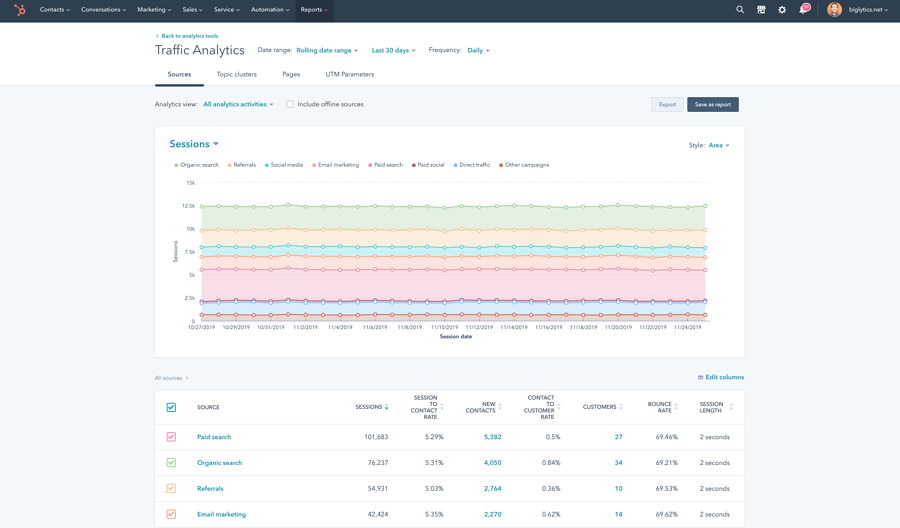-
Digital Marketing
We help you to use your digital potential. For a strong positioning, more visibility and more leads.
Get Growth ready
With the BEE.Transformance model, we bring continuous and profitable growth to your company. A new mindset for your team.
Industries
We transform your challenges into opportunities through the experience we have gained from projects in these industries.
-
HubSpot Services
As a HubSpot Diamond Partner, we help you implement your digital growth strategy with a focus on performance - by implementing and integrating new and existing systems as well as 3rd party apps.
HubSpot Thought Leader
As a HubSpot Diamond Partner with +50 certifications, host of the HubSpot User Group Zurich, HubSpot Trainer and HuSpot User Champions, you have access to in-depth HubSpot expertise.
HubSpot Solutions
The BEE.Theme offers you more creative freedom than any other theme on the market. Whether you're a beginner or a professional, a creative mind or a digital agency - with the BEE theme, you can easily unleash the maximum power for your pages in HubSpot CMS.
-
BEE.Blog
Knowledge around digital marketing, digital sales, technology, data intelligence and employees.
Knowledge Base
Pure knowledge: everything essential concentrated, compact, digitally prepared for you and ready to download.
What is inbound?
The most effective way to successfully combine digital marketing and digital sales.
-
BEE.Team
The BEE.Performers: many different characters - with one thing in common: the fascination for a digital world.
References
More than 100 large and small companies have already started with BEE: to more visibility, more performance, more growth.
Invest
Participate in the growth of BEE and become part of the BEE Growth Story by purchasing Digital Share Tokens.
We're hiring
Become a BEE.Performer! Are you ready for your own transformation?
Here’s Why Your HubSpot Lead Nurturing Isn’t Working
There are 4 billion daily email users, and somewhere in that crowd are your customers. So, you do what all good inbound marketers do: you send lead nurture emails. According to HubSpot, there’s a 4,200% ROI for every $1 you spend on email marketing –– and you’d like some of that, please.
But, what happens if your email marketing campaign isn’t turning out how you’d hoped? Perhaps your audience isn’t the email reading type. Maybe you should focus on something else, like social media, videos, webinars...
Stop! Don’t give up on your lead nurturing just yet.
Your email contact list is one of your company’s most essential assets. When you plan, execute and manage your email campaigns correctly, you should be seeing the desired results. You may just need a little steering in the right direction. To help you, we’ll address the issues that are holding your lead nurturing strategy back.
1. You’ve slipped into outbound mode
You know that HubSpot is built on the inbound marketing philosophy, right? This means that the emails you send should be all about your buyer persona and their pain points, not the benefits and features of your products and services, complete with twenty “BUY NOW!” call-to-actions.
Remember, you want to educate your readers––in a friendly, approachable way. Address the concerns and problems that your buyers have with helpful, genuinely useful information that makes them naturally want to take the next step. If you position yourself as a knowledgeable expert, they’ll look forward to receiving and opening your mail. What useful tips and subject-specific information have you got to share that provides practical solutions? Of course, ultimately, you want the lead to make a purchasing decision, but you’re not going to achieve that with a five-foot monologue about how great your brand is.
Build trust, encourage engagement and questions. That’s what lead nurture is all about. Start by having an honest look at what you’re sending out and make sure that it’s less about you and more about them.
2. You’ve lost touch with the buyer’s journey
Awareness > Consideration > Decision
Timing is everything.
Where, in the great scheme of things, is your lead positioned?
If you’re rushing with decision level material, you’re likely to be overwhelming your customer. They haven’t learned enough about their pain point and all the possible solutions to have faith in the fact that your product or service is the solution for them.
So, hold your horses for a second and take the time to find out where your customer is at. You can send an email that asks a few simple questions about what kind of content they’d prefer to receive. Ask about their problem or the particular area of a subject matter they’re interested in. Then, send information that will help to educate them. That’s how you build the foundation of your relationship.
Eventually, they’ll be comfortable enough to progress to the next stage. Some leads may only just be getting to grips with what they need; they may not have the budget to commit yet, they may have to consult with other stakeholders in their business before they can sign on the dotted line. If you’re coming on too strong and too eager, they may grow suspicious. Why the hard sell?
Structure your messaging around the sales funnel and the buyer’s journey so that you’re always showing up in your lead’s inbox, exactly at the right time.
3. Emails for nowhere
- One of your goals is to deliver useful, helpful information to your leads – your email must have the right intent. But without setting up KPIs, how will you know whether your outreach has been successful or effective?
When you start out with your lead nurture campaign, identify your objective. Is it to increase engagement or conversion? Then, identify the type of content that’s going to help you achieve these goals. Each time you send an email that promotes this content, track open rates, clickthroughs and follow-ups. By doing this, you’ll understand what works and what doesn’t. You can then make meaningful adjustments to your campaign to ensure you’re bringing value to your lead with each interaction, not just a “Hi, I’m here.” reminder.
If you’re hoping that by sending enough fluffy emails, you’ll eventually get results, you may be sorely disappointed. A bit like a nosey neighbour that’s always popping their head over the fence, you’re likely to be avoided and banished to the trash basket.
To optimise your emails, you need to consider these essential email metrics:
Clickthrough rate
Conversion rate
Bounce rate
List growth rate
Forwarding rate
Overall ROI
Open rate
Unsubscribe rate
Each of these shows you how your emails are performing within the context of the goals you’ve set for your email marketing campaign. So, if your lead nurtures have been ineffective so far, start here.
4. You’re only as good as your subject line
The honest truth is, you’re not the first and only business that’s going to email your leads. Tonnes of other organisations are vying for their attention. Therefore, your approach must be strategic, engaging and intelligent––on every level.
From the quality of content you send, the language you use, and even how you time your automated emails––it all matters. If you sell high-end products with a long purchasing decision process, don’t bombard the lead with a cluster of emails within the first week of them engaging with your business. How you automate your workflows should reflect the buying process.
When your customer is sufficiently familiar with your business and is making their way through the educational content you’re sending, you can move the relationship to the next level. For example, you can use a more personalised approach in your writing style, invite them to a quick video call or an online demo.
It’s important to inject your emails with a human touch––we all know where boring, generic emails end up. So be original, authentic and engaging. But, when you do this, make sure it’s tactful, sensitive and aligned to your brand’s core values.
Sales success with HubSpot Lead Nurturing
Email marketing is very much alive and kicking. In fact, research shows a 78% increase in email engagement over the last year––it’s a train you don’t want to miss. There are, of course, plenty more tips and suggestions we can provide you with to ensure your email campaigns are optimised and your HubSpot lead nurturing is successful. We can help you with the creative side of things, as well as all the other important stuff, like distribution, reporting and continuous campaign improvement. Click here to learn more.
Comment
Related Posts

How to Uncover Your Customer's Key Pain Points
Manuela Krapf | 7 Jul 2022
In inbound marketing, we talk a lot about "pain points". But what exactly are they? Why are they so important? What's the danger in focusing on the wrong pain point?
reading time: 9min
Zum Blog

HubSpot Reporting: Best Practices and Things You Must Know
Romy Fuchs | 15 Sep 2022
Sales and marketing reports are powerful tools you can rely on when making essential business decisions and planning for the future. Each campaign you launch opens the ...
reading time: 10min
Zum Blog

5 Signs That You Should Immediately Change Your Marketing Agency
Ben Klein | 4 Nov 2021
When you decide to invest in the services of a marketing agency, it's usually because you've recognised that there are aspects of your marketing that would be better ...
reading time: 7min
Zum Blog
